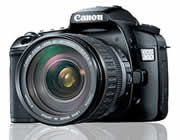Canon EOS 30D Digital
Canon Updated: 2007-05-31Canon's new EOS 30D brings proven EOS technology to a new level, giving photographers an unbeatable photographic experience. The EOS 30D incorporates a host of new features with Canon's highly acclaimed 8.2 megapixel CMOS sensor and DIGIC II Image Processor. The EOS 30D includes enhanced operational features such as a new 2.5 inch LCD monitor, true spot metering, a durable new shutter mechanism and Canon's Picture Style feature, all in a sturdy, magnesium-clad body. With all these new features the EOS 30D is truly perfection, refined.
- Exceptional digital SLR with exclusive 8.2 Megapixel Canon CMOS Sensor and DIGIC II Image Processor
- User-selectable high-speed and low-speed continuous shooting at 5 fps or 3 fps - up to 30 (JPEG), 11 (RAW) or 9 (RAW+JPEG) consecutive frames when set at 5 fps and fast 0.15-second startup time
- Large 2.5 inch LCD monitor that can be viewed at extreme angles up to 170°
- New and improved features: Picture Style for superior command of in-camera color, contrast and sharpness, spot metering and shutter durability of approximately 100,000 cycles
- Impressive 9-point Wide-area AF with a dual precision sensor at the center
- One-touch direct printing and improved PictBridge features, including more custom print effects and printing with shooting information
- Fully compatible with all EF and EF-S Lenses and a wide range of EOS System accessories
Exceptional digital SLR with exclusive 8.2 Megapixel Canon CMOS Sensor and DIGIC II Image Processor
8.2 Megapixel CMOS Sensor
Canon's large-area CMOS (complementary metal oxide semiconductor) sensor captures images with exceptional clarity and tonal range, and offers the most pixels in its class. This APS-C size sensor (22.5 x 15.0mm) has the same 3:2 ratio as film cameras, enabling an effective angle of view that is 1.6x the normal EF Lens focal length. The EOS 30D has an extensive ISO range (from 100 to 1600 plus ISO 3200 in extended mode), which is selectable in 1/3-stop increments. The sensor features a newly developed set of narrow-gap microlenses and noise reduction circuits to improve performance at high ISO values, and optimized photodiode configurations for improved performance at all ISO values. This results in larger, clearer, sharper and more detailed photographs right from the start.
DIGIC II Image Processor
The EOS 30D is the product of Canon's extensive in-house development: The DIGIC II Image Processor was designed specifically for Canon digital SLRs and enhances every aspect of image capture. Information captured by the CMOS sensor is processed and assembled into images of exceptional quality. With the DIGIC II Image Processor on board, photographers can expect natural color reproduction, precise white balance in any number of lighting situations and unparalleled clarity. The DIGIC II Image Processor employs sophisticated signal processing algorithms and works at greater speeds, all while consuming less energy. The entire processing chip - not just the software that drives it - is dedicated for use in a digital still camera.
EOS 30D Introduction Manual (PDF, 6.15 MB)
EOS DIGITAL Software Guide (PDF, 560 KB)
EOS Utility Instruction Manual Windows (PDF, 1.69 MB)
EOS Utility Instruction Manual Macintosh (PDF, 1.56 MB)
Digital Photo Professional Instruction Manual Windows (PDF, 11.4 MB)
Digital Photo Professional Instruction Manual Macintosh (PDF, 14.4 MB)
ZoomBrowser EX Instruction Manual Windows (PDF, 4.97 MB)
ImageBrowser Instruction Manual Macintosh (PDF, 4.60 MB)
Related Manuals
Canon EOS 5D Digital
Canon Digital Rebel XTi
Canon Digital Rebel XT
Canon EOS-1D Mark II N Digital
Canon EOS-1Ds Mark II Digital
Canon EOS-1v
Canon EOS-3
Canon EOS-1D Mark III
Canon EOS ELAN 7NE
Canon EOS Rebel T2
Canon EOS Rebel K2
Canon EF 16-35mm f/2.8L II USM
